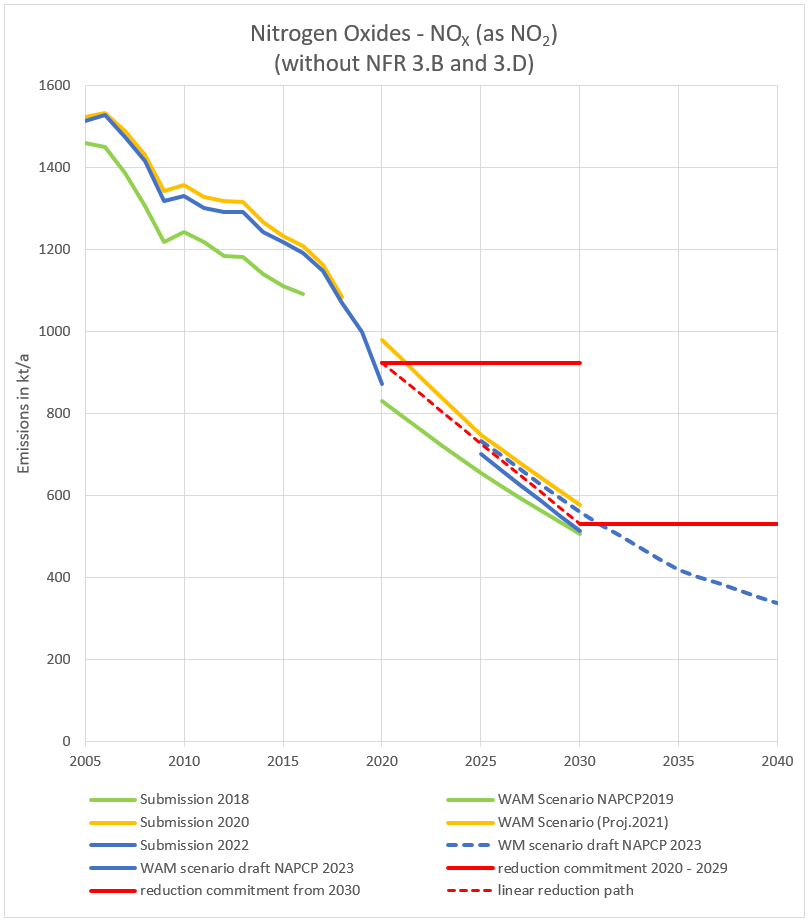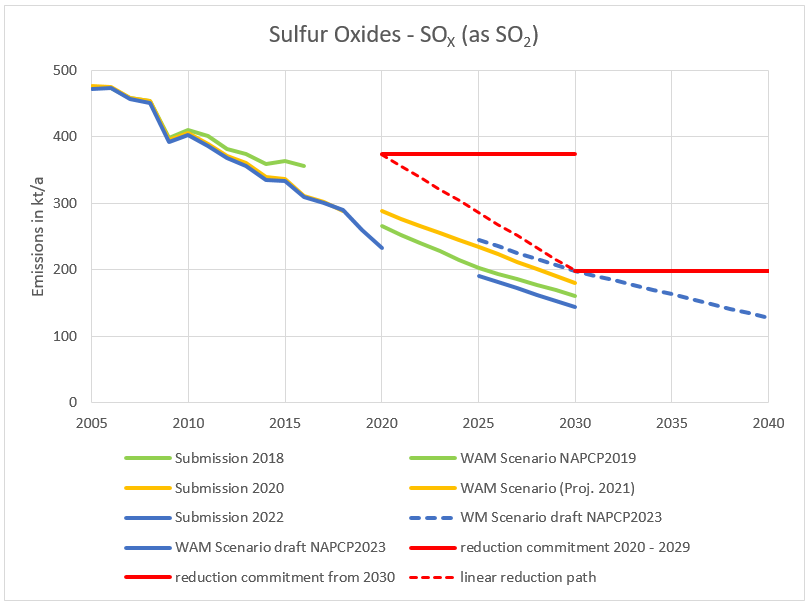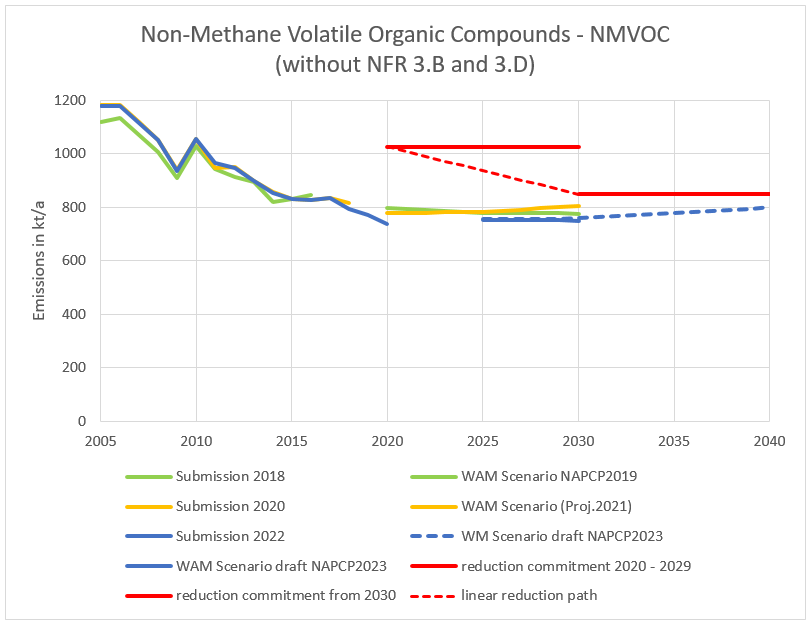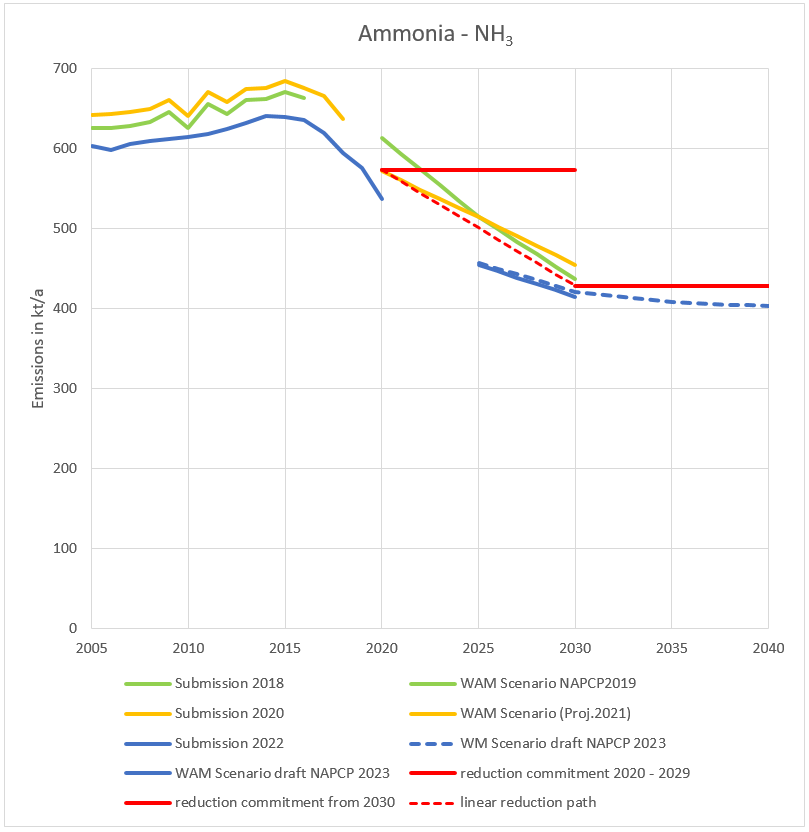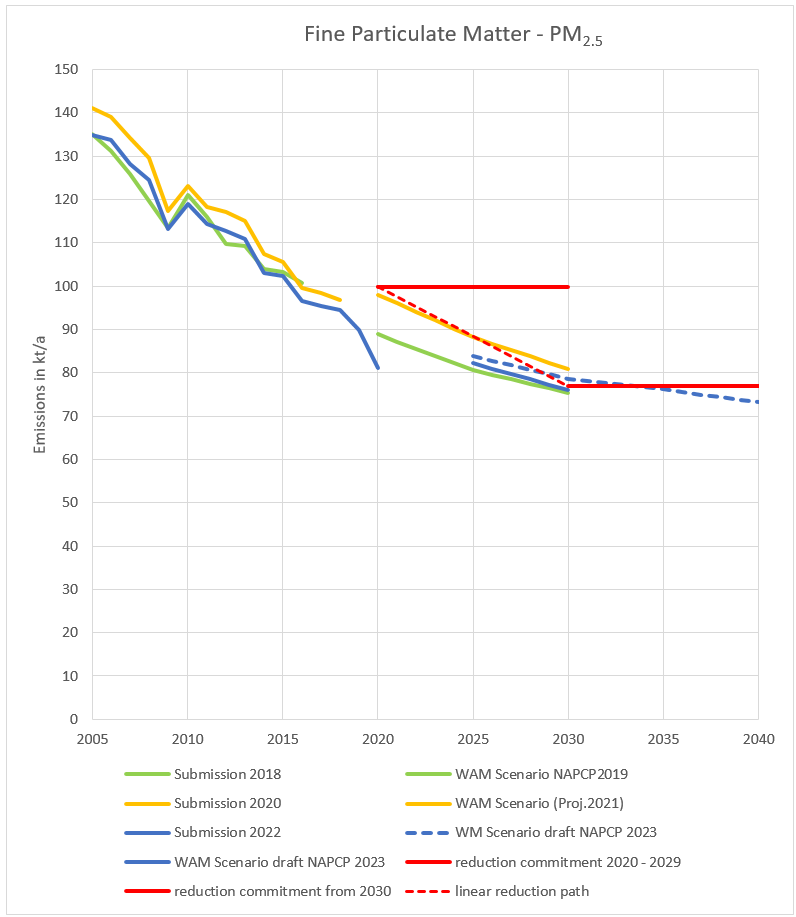Table of Contents
Recalculations
Due to recalculations in each underlying emission inventory submission, all calculations of emission reduction potentials in the WM and WAM scenario of the respective projection are regularly updated. Furthermore, additional measures that had been included in the WAM scenario in the projection before can become part of the WM scenario in the following projection, as they were put into force in the meantime (e. g. 44th BImSchV). In addition, updated GHG emission projections using most recent projections of economic and other parameters result in a new projection of activity rates that needs to be considered for updating the emission projections of air pollutants. For the draft German NAPCP of 2023, which is the draft of the second German NAPCP under directive (EU) 2016/2284, last step to check was, whether new additional measures are needed for compliance to the emission reduction commitments, because of the updates described above.
The following figures show the differences between inventory submissions 2018, 2020 and 2022 for historic emissions as well as the differences between the WAM emission projections reported in 2019 (consistent with the NAPCP 2019), reported in 2021 and reported in 2023 (consistent with the draft NAPCP 2023) for each pollutant. In addition, for the emission projections 2023 the WM scenario is shown up to the year 2040. For each pollutant a brief explanation of the most relevant reasons for the occurring differences compared to the previous reporting is given. For explanation of the differences between reporting in 2021 and 2019 please see the IIR of the 2021 reporting1).
For NOX, recalculations within the inventory submission 2022 lead to changes in historic years predominantly in sector 2.B.2 (nitric acid production)2), that were compensating the positive recalculations from inventory submission 2021, when comparing submissions 2022 and 2020. The current WM scenario is slightly below the WAM scenario of the 2021 projection. Main reasons are the updates in road transport emission factors in HBEFA 4.2 (aging factors, etc.) as well as a higher share of electric vehicles in the 2030 fleet. The current WAM scenario goes further below the WAM scenario of the 2021 projection. An accelerated coal phase-out by 2030, introduction of Euro 7 and a higher share of electric vehicles in the fleet in 2030 in the WAM scenario of the draft NAPCP 2023 are the main drivers for additional emission reductions.
In 2020 a significant drop of mileage, against an increasing long-term trend, especially for passenger cars appeared. In combination with an ongoing decrease in the implied emission factors through regular fleet renewal, an extraordinary decrease in NOX emissions was the result. This drop in overall mileage of passenger cars, probably caused by the lockdown period during the pandemic as well as a higher share of home office workers, does not appear to be continuing in the coming years. Therefore, the projection follows the long-term trend of increasing mileage, especially for passenger cars. Projected potential emission reductions in road transport are therefore only caused by a further decrease of implied emission factors of the fleet, by regular fleet renewal, Euro 7 and an increasing share of electric vehicles.
For SOX, the current WM scenario is slightly above the WAM scenario of the 2021 projection, mainly because of more conservative assumptions regarding decline in SOX emissions from the industry sector. Due to the accelerated coal phase-out by 2030 the current WAM scenario is below the former WAM scenarios with a coal phase-out until 2038.
NMVOC emission projections are strongly influenced by economic projections. Updates on these are therefore causing changes in NMVOC emission projections. However, the latest historic emissions in 2020 are already below the current projections for 2025 to 2040 in the draft NAPCP 2023, which is caused by decreases over all sectors.
Submission 2021 contained recalculations of NH3 emissions in historic years mainly because of introducing dairy heifers (dairy and slaughter heifers are now treated separately in the inventory) and a methodological change in emission calculations for inorganic fertilisers, leading to significantly lower emissions and less variation from one year to another3). This is the main reason that emission projections of the draft NAPCP 2023 are systematically lower than former projections. As a result, absolute emissions to be reached in 2020 and 2030 following the relative reduction commitments are lower than before. Despite a similar trend in the current emission projections compared to 2021 WAM projection, assumptions of reduction potentials of WM and WAM measures are more conservative now, but compensated by assuming further decreases in animal numbers, especially cattle. This is further explained in the draft NAPCP 2023.
Differences in current projections of fine PM emissions (PM2.5) are a consequence of many factors.
First, recalculations took place in submission 2021 in sector 2.G in the use of fireworks and the use of tobacco4) and in submission 2022 in 1.A.3.d. ii (national navigation)5) leading to lower PM2.5 emissions over all historic years compared to submission 2020. The change in 2005 results in lower absolute emissions to be reached in 2020 and 2030 regarding the relative emission reduction commitments compared to the 2021 projections and further in systematically lower projections based on submission 2022 compared to 2021 projections. Still, the WM scenario of the draft NAPCP 2023 is above the WAM scenario of the NAPCP 2019 because of the same reason as in 2021 projection (more conservative methodology to project activity rates in certain industrial sectors)6). Finally, the current WAM scenario is compliant with the emission reduction commitment in 2030 due to additional emission reductions through the accelerated coal phase-out by 2030 and the road transport package. Increasing emissions in the building sector due to a projected increase in biomass use can be compensated by additional measures to further reduce the implied emission factors of small combustion installations burning woody biomass. However, if looking at the year 2020 of submission 2022 current WM and WAM scenario are quite conservative due to conservative assumptions over almost all sectors.
